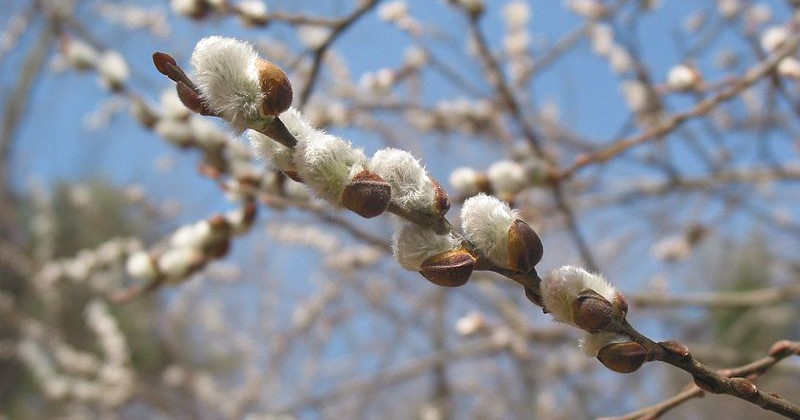Pussy willow (Salix discolor)
A large shrub, or small to medium-sized multi-trunked tree found across Canada, south to Montana and S. Dakota, and in the East, from Newfoundland to Delaware; inhabiting old fields and swamps, found along roadsides, wetland shorelines and in disturbed areas; thrives in wet soils, but adapts well to drier sites; critical pollen source for early-emergent insects; one of the most popularly recognizable native shrubs, appreciated for its early flower bud display.
 An old field specked with budding pussy willows (Salix discolor) is like a constellation come to earth, descended from the heavens and hovering just above the ground. On a dim late winter’s afternoon, pussy willows spark and scint in a landscape still in thrall to monochromatic cold. Everyone notices pussy willows, and feels their encouragement in the waning winterscape.
An old field specked with budding pussy willows (Salix discolor) is like a constellation come to earth, descended from the heavens and hovering just above the ground. On a dim late winter’s afternoon, pussy willows spark and scint in a landscape still in thrall to monochromatic cold. Everyone notices pussy willows, and feels their encouragement in the waning winterscape.
Insects notice too: for some native pollinators, pussy willows offer a first, important source of pollen and nectar in very early springtime. Look closely at the male catkins, or aments, that follow the buds and you will see a roil of small wasps, ants and bees (Hymenoptera) and varieties of flies (Diptera), all crawling, burrowing, bumping, flitting and wriggling in benign competition while foraging the flowers for nectar and pollen. There must be joy equal to our own in this early benison.
Other creatures join in the celebration and feast. Donald Culross Peattie writes, “It is a poor Pussy Willow that does not have a song sparrow perched in it at this season, his throat vibrating with the tumbled, jingling notes of his early love song”.[i]
Willows comprise North America’s largest genus of “tree-like plants”[ii], approximately one hundred species plus an ambivalent number of hybrids. Some taxonomists balk at calling willows trees and it is true that few native species achieve much stature. Most willows are short-lived and their wood is brittle. Salix discolor grows only twelve to fifteen feet tall and its trunk usually measures fewer than eight inches in diameter; more often pussy willows are multi-trunked and shrub-like in demeanor.
The largest native willow is the black willow (Salix nigra). In the 2008 Centennial Edition of Forest Trees of Maine, the “champion” black willow cited is an eighty-four-foot-tall Yarmouth specimen, with a crown spreading sixty-nine feet.[iii] Southeastern Maine is the northern limit of the black willow. Antipodally, the smallest native northeastern willows inhabit the alpine zones of Mounts Washington and Katahdin, prostrating themselves before dwarfing gales, and beneath relentless snowpacks. The relatively large catkins of these diminutive willows are often taller and more prominent than their ground-hugging, matted branches, found tangled among mosses and lichens.[iv]
Willows bud and flower throughout the weeks of late winter, well into spring, thus offering vital food for pollinators over a long season. Salix discolor is the earliest to bud with its familiar “pussies”, and it is the earliest to produce nectar and pollen on its flowers. The number and variety of insects enticed and hosted by Salix discolor make this small tree a lively and valuable component of the landscape.
Having a food source (plenty of pollen, and nectar with a high-sugar content[v]) for early pollinators is significant. And a plant that woos and feeds insects succors birds. This is one of the simplest of natural equations that we can see for ourselves. Insect congregants, their eggs and larvae (caterpillars) provide hungry passerine migrants like flycatchers, warblers and catbirds, with easy protein; precocious nesters, especially our year-round northern residents like chickadees and American goldfinches, benefit as well.
Douglas Tallamy lists willows as second only to oaks in value as host trees for Lepidoptera (butterflies and moths).[vi] Among the many caterpillars found dining upon Salix discolor leaves are the larvae of charismatic viceroy (Limenitis archippus) and mourning cloak (Nymphalis antiopa) butterflies. Hairstreaks (Strymon spp.) sphinx moths (Sphingidae) and comma moths (Polygonia comma) also dine on willows.
The sketch of willow feeders continues with leafrollers, sawflies, borers, midges and gall gnats. The latter insects, specifically the larvae of the gall gnat Rhabdophaga strobiloides, produce an ornamental aberration called a pine-cone gall, easily visible on twig tips when willows shed their leaves. All of these represent long-evolved plant-insect associations, not to be confused with infestations more often caused by exotic, introduced insect species like gypsy moths or Japanese beetles.
Willow’s affinity for wetlands gives shelter and food to birds in habitats less favored by some predators. And willow’s prodigious seed squall feeds ducks and other waterfowl. In spite of all the flying insects (bumblebees, Bombus family, digger bees, Andrenidae, and Syrphid flies, Syrphidae)[vii] drawn to pussy willow catkins, wind is the primary means of willow pollination. Nearby water provides an effective medium for seed distribution. Willow pollen is copious; seeds are lightweight and abundant. Both are easily loosened by the slightest breeze, or carried distances from parent plants by stronger winds and fast-flowing water, contributing to healthy willow genetics and a tendency to willow promiscuity (hybridization).
M. Forster exhorts his readers to “avoid muddles” and it is tempting to avoid the muddle of willow classification and willow hybrids. Henry David Thoreau said, “The more I study willows, the more I am confused”.[viii] Maine’s wunderkind botanist Arthur Haines calls Salix “a difficult genus”[ix], and almost every field guide cautions against finding satisfaction in identifying willows. New England is not yet plagued with many introduced non-native shrub willows encroaching upon the landscape. Very generally, if you see an early “pussy willow” in northern New England, it is a pussy willow, Salix discolor. When leaves appear, precise identification might be easier. The species name “discolor” refers to the contrast between the deep green leaf surface and its pale underside. Also, pussy willow leaves tend to look fat or broad, not as slender as the leaves of other shrub willow species.
Pussy willows are easy to start from seed collected in mid-spring when the catkins look cottony. Sow seed immediately on soil surface with the silky seed hairs attached (these help seeds adhere to the soil medium.) Keep containers moist. Propagation by seed is sexual reproduction, dependant upon pollination., Willows can also be propagated vegetatively, that is, by cuttings. One to two-foot lengths of last year’s wood (growth) can be plunged directly into the ground in mid-spring when the catkins are maturing. Willows produce their own rooting hormones; willow pieces soaked in water provide an exudate that can be used to stimulate the root growth of other plant cuttings. Riparian restoration projects often employ willow cuttings because they root quickly, and the resultant root systems stabilize erodable soil. Willows thrive in seasonally flooded areas.
By Pamela Johnson
[i] Peattie, Donald C. 2007. A Natural History of North American Trees. Boston: Houghton Mifflin Company.
[ii] Sibley, David. 2009. The Sibley Guide to Trees. New York: Alfred A. Knopf.
[iii] Maine Forest Service. 2008. The Forest Trees of Maine. www.maineforestservice.gov.
[iv] Slack, Nancy G and Allison W. Bell. 1995. AMC Field Guide to the New England Alpine Summits. Boston: Appalachian Mountain Club Books. Alpine willows including Salix argyrocarpa, S. uva-ursi, S. herbacea, and S. arctophila, are rare, and of conservation concern. Proximity to hiking trails on narrow summits makes them vulnerable to foot-traffic. Also, there is no place for alpines to go in a warming climate.
[v] Henrich, Bernd. “Bee flowers…” Evolution. 29(2): 325-334.
[vi] Tallamy, Douglas. 2007. Bringing Nature Home. Portland, Oregon: Timber Press, Inc.
[vii] Eastman, John. 1995. The Book of Swamps and Bogs. Mechanicsburg, PA: Stackpole Books.
[viii] Ibid. p.228
[ix] Haines, Arthur. 2011. Flora Novae-Angliae. New Haven, CT: New England Wild Flower Society/ Yale University Press. The arcana of characteristics used for accurate willow identification (leaf hairs, stipules, branch brittleness, etc.) is a guilty pleasure for some botanists. These features are not present simultaneously, so it is often necessary to use herbarium specimens for reference. Add to that seasonal and environmental variability, (called phenotypical plasticity), as well as ease of hybridization, and you have a picture of the rich swamp that is willow nomenclature.

